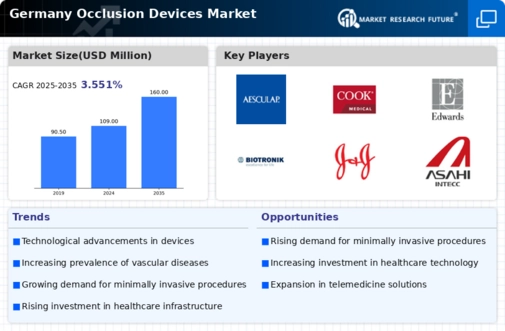Supportive Regulatory Environment
The regulatory landscape in Germany is becoming increasingly favorable for the occlusion devices market. The German Federal Institute for Drugs and Medical Devices (BfArM) has streamlined the approval process for innovative medical devices, which is likely to encourage manufacturers to introduce new products. This supportive regulatory environment is essential for fostering innovation and ensuring that patients have access to the latest treatment options. Additionally, reimbursement policies are evolving to cover a broader range of occlusion devices, making them more accessible to patients. As reimbursement rates improve, healthcare providers are more inclined to adopt these devices, further driving market growth. A supportive regulatory framework combined with favorable reimbursement policies is expected to significantly impact the occlusion devices market in Germany.
Advancements in Medical Technology
Technological innovations play a vital role in shaping the occlusion devices market. The introduction of advanced materials and design improvements has enhanced the efficacy and safety of these devices. For instance, the development of bioresorbable occlusion devices is gaining traction, as they offer temporary occlusion without the need for permanent implants. This shift towards more sophisticated technology is likely to attract healthcare providers and patients alike, thereby expanding the market. In Germany, the medical technology sector is robust, with investments in research and development reaching approximately €3 billion annually. This investment fosters an environment conducive to innovation, which is essential for the growth of the occlusion devices market. As technology continues to evolve, it is expected that the market will witness a surge in demand for cutting-edge occlusion solutions.
Rising Awareness and Patient Education
The growing awareness of occlusion devices among healthcare professionals and patients is a notable driver for the market. Educational initiatives and campaigns aimed at informing both medical practitioners and patients about the benefits and availability of these devices are becoming more prevalent. In Germany, healthcare organizations are increasingly focusing on patient education, which is essential for informed decision-making regarding treatment options. This heightened awareness is likely to lead to increased adoption of occlusion devices, as patients become more proactive in seeking out effective solutions for their medical conditions. Furthermore, as healthcare providers emphasize the importance of patient-centered care, the demand for occlusion devices is expected to rise. Thus, the rising awareness and education surrounding these devices are pivotal in shaping the future of the occlusion devices market.
Increasing Prevalence of Cardiovascular Diseases
The rising incidence of cardiovascular diseases in Germany is a crucial driver for the occlusion devices market. As per recent health statistics, cardiovascular diseases account for a significant portion of mortality rates, prompting healthcare providers to seek effective treatment options. This trend is likely to escalate the demand for occlusion devices, which are essential in various interventional procedures. The market is projected to grow at a CAGR of approximately 6.5% over the next few years, reflecting the urgent need for innovative solutions in managing these conditions. Furthermore, the increasing awareness among patients regarding treatment options is expected to further boost the market, as more individuals seek medical intervention for cardiovascular issues. Thus, the growing prevalence of these diseases is a pivotal factor influencing the occlusion devices market in Germany.
Aging Population and Increased Healthcare Expenditure
The demographic shift towards an aging population in Germany significantly drives the occlusion devices market. As individuals age, the likelihood of developing conditions requiring occlusion devices, such as aneurysms and vascular diseases, increases. The elderly population is projected to rise to 25% by 2030, which will likely lead to higher healthcare expenditures. In 2025, healthcare spending in Germany is expected to reach approximately €500 billion, with a substantial portion allocated to advanced medical devices. This increase in healthcare expenditure indicates a growing commitment to improving patient outcomes through innovative treatments. Consequently, the aging population and the corresponding rise in healthcare spending are likely to propel the demand for occlusion devices, making it a critical factor in the market's growth.

















Leave a Comment